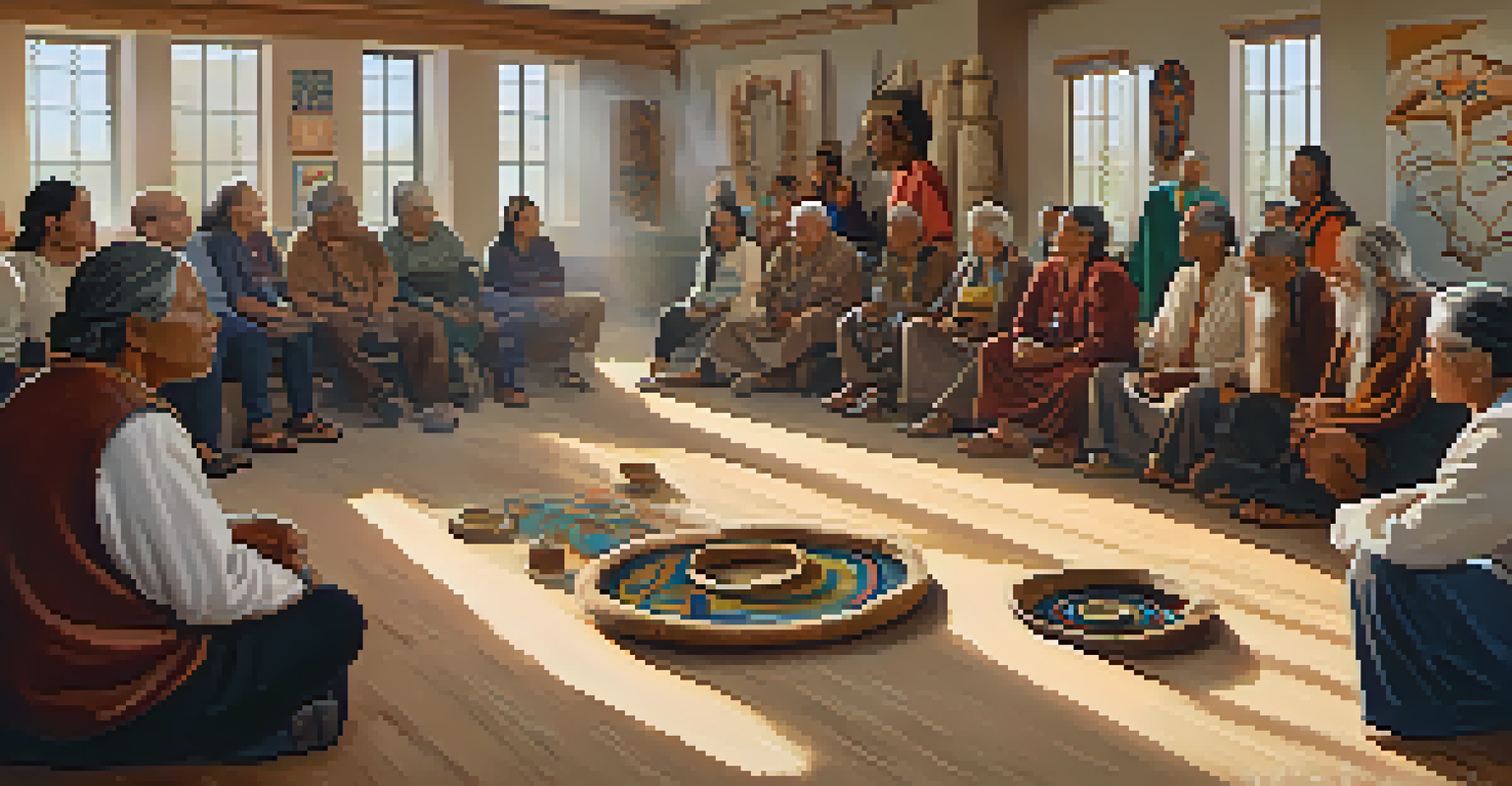Case Studies on Indigenous Rights and Entheogen Use

Understanding Entheogens and Their Cultural Significance
Entheogens are substances used in spiritual or religious contexts to elicit altered states of consciousness. Many Indigenous cultures have traditionally used these substances, such as ayahuasca or peyote, as part of their rituals and healing practices. The use of entheogens often embodies a deep connection to nature and the spiritual world, illustrating how these practices are integral to cultural identity.
The plants are our brothers and sisters. They are part of us and we are part of them.
In many Indigenous communities, entheogens are not merely tools for recreation but are revered as sacred gifts from nature. This perspective enhances the importance of protecting these practices as part of their cultural heritage. As modern society increasingly recognizes the potential benefits of entheogens, the challenge arises to respect and preserve the Indigenous knowledge surrounding their use.
Understanding the cultural significance of entheogens is crucial when discussing Indigenous rights. The intertwining of spirituality, tradition, and community means that any infringement upon these practices can be seen as an attack on their identity, making legal protections essential.
Historical Context of Indigenous Rights and Entheogen Use
The history of Indigenous peoples and their relationship with entheogens is marked by colonialism and repression. European colonizers often viewed these practices as primitive or barbaric, leading to the criminalization of entheogen use among Indigenous communities. This historical backdrop has created ongoing struggles for Indigenous rights, particularly regarding the preservation of their cultural practices.

In the 20th century, some Indigenous groups began to reclaim their rights to use entheogens as part of their spiritual practices. Legal battles have emerged, challenging the restrictions imposed by governments that historically marginalized these cultures. The emergence of these cases highlights the ongoing tension between federal regulations and Indigenous sovereignty.
Entheogens and Cultural Identity
Entheogens are vital to Indigenous cultures, serving as sacred tools that connect spirituality and tradition.
This historical context is paramount to understanding the present-day struggles for Indigenous rights. As Indigenous communities fight to regain their cultural practices, the dialogue around entheogens has shifted from marginalization to recognition, emphasizing the need for respect and understanding.
Case Study: The Native American Church and Peyote
One of the most prominent examples of entheogen use in the context of Indigenous rights is the Native American Church's use of peyote. This cactus, which contains psychoactive properties, has been used by Indigenous peoples for centuries in spiritual ceremonies. The church argues that peyote is essential to their religious practices and is therefore protected under the First Amendment.
Cultural appropriation is like a thief in the night. It takes what is sacred and turns it into a commodity.
Despite its significance, the legal status of peyote has faced challenges, particularly as non-Indigenous people have begun to use it for recreational purposes. This has led to concerns about overharvesting and the sustainability of peyote populations. The Native American Church advocates for the preservation of their traditional practices while also addressing these environmental concerns.
The case of the Native American Church illustrates the complexities of balancing Indigenous rights with environmental stewardship. It emphasizes the need for legal frameworks that not only respect Indigenous traditions but also ensure the sustainability of the natural resources they rely on.
Case Study: Ayahuasca and Indigenous Communities in the Amazon
In the Amazon, ayahuasca is used by various Indigenous tribes for healing and spiritual purposes. The brew, made from the ayahuasca vine and other plants, has gained popularity in Western culture, leading to a surge in tourism and commercialization. This influx poses significant challenges for Indigenous communities, who are struggling to protect their traditional knowledge and practices.
As outsiders seek authentic experiences with ayahuasca, Indigenous groups have voiced concerns about cultural appropriation and the commodification of their sacred rituals. They argue that these practices are not mere products to be consumed but are deeply rooted in their cultural identity and spirituality. This highlights the importance of recognizing and respecting the origins of such practices.
Legal Protection for Indigenous Rights
The establishment of legal frameworks is essential to safeguard the rights of Indigenous communities to practice their cultural rituals involving entheogens.
The case of ayahuasca in the Amazon showcases the ongoing struggle between cultural preservation and commercial exploitation. It serves as a reminder that Indigenous rights must be at the forefront of discussions surrounding entheogen use, ensuring that communities are empowered to protect their heritage.
The Role of Legal Frameworks in Protecting Indigenous Practices
Legal frameworks play a crucial role in safeguarding the rights of Indigenous communities to use entheogens. Various legal battles highlight the need for laws that recognize the spiritual and cultural significance of these substances. For example, some jurisdictions have begun to grant exemptions for Indigenous groups, allowing them to continue their traditional practices without legal repercussions.
However, the effectiveness of these legal protections often varies, leading to ongoing disputes between Indigenous groups and government entities. Many Indigenous advocates argue for comprehensive legislation that explicitly acknowledges their rights to use entheogens as part of their cultural heritage. This would not only protect their practices but also promote greater understanding and respect for Indigenous cultures.
Ultimately, the development of inclusive legal frameworks is essential for the preservation of Indigenous rights. Such measures can pave the way for more equitable relationships between Indigenous communities and state authorities, ensuring that their spiritual practices are honored and protected.
Cultural Awareness and Education on Indigenous Rights
Cultural awareness and education are vital components in supporting Indigenous rights, especially regarding entheogen use. By fostering understanding of Indigenous traditions, non-Indigenous individuals can actively advocate for the rights of these communities. Educational initiatives can empower people to recognize the significance of entheogens within Indigenous cultures and encourage respect for their practices.
Workshops, lectures, and community events can help bridge the gap between Indigenous and non-Indigenous peoples. These platforms allow for meaningful dialogue about the importance of preserving Indigenous rights and the cultural significance of their practices. Increased awareness can lead to greater advocacy efforts and support for Indigenous communities.
Cultural Awareness Fuels Advocacy
Education and cultural awareness are key to supporting Indigenous rights, promoting respect for their traditions and practices surrounding entheogens.
The role of education in promoting Indigenous rights cannot be overstated. By creating spaces for knowledge exchange, society can work towards dismantling stereotypes and fostering respect for the rich cultural heritage of Indigenous peoples.
Future Directions for Indigenous Rights and Entheogen Use
Looking ahead, the future of Indigenous rights and entheogen use is filled with both challenges and opportunities. As interest in entheogens continues to grow globally, Indigenous communities must navigate the complexities of preserving their practices while engaging with a wider audience. This balancing act requires strategic advocacy and collaboration to ensure their rights are upheld.
New research and increased public interest in the therapeutic benefits of entheogens present a unique opportunity for Indigenous groups. By sharing their traditional knowledge, they can play a pivotal role in shaping the conversation around entheogens while maintaining control over their use. This can lead to a greater appreciation for Indigenous practices and highlight the importance of their perspectives.

Ultimately, the future depends on fostering respectful partnerships that honor Indigenous rights and traditions. By prioritizing these values, society can work towards a more inclusive and equitable understanding of entheogen use, ensuring that Indigenous voices are heard and respected.